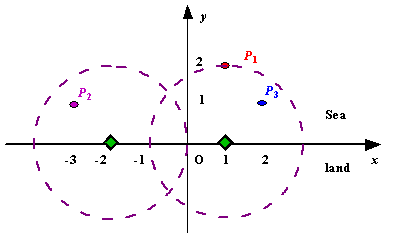Radar Installation
| Time Limit: 1000MS | Memory Limit: 10000K | |
| Total Submissions: 75881 | Accepted: 16994 |
Description
Assume the coasting is an infinite straight line. Land is in one side of coasting, sea in the other. Each small island is a point locating in the sea side. And any radar installation, locating on the coasting, can only cover d distance, so an island in the sea can be covered by a radius installation, if the distance between them is at most d.
We use Cartesian coordinate system, defining the coasting is the x-axis. The sea side is above x-axis, and the land side below. Given the position of each island in the sea, and given the distance of the coverage of the radar installation, your task is to write a program to find the minimal number of radar installations to cover all the islands. Note that the position of an island is represented by its x-y coordinates.

Figure A Sample Input of Radar Installations
We use Cartesian coordinate system, defining the coasting is the x-axis. The sea side is above x-axis, and the land side below. Given the position of each island in the sea, and given the distance of the coverage of the radar installation, your task is to write a program to find the minimal number of radar installations to cover all the islands. Note that the position of an island is represented by its x-y coordinates.

Figure A Sample Input of Radar Installations
Input
The input consists of several test cases. The first line of each case contains two integers n (1<=n<=1000) and d, where n is the number of islands in the sea and d is the distance of coverage of the radar installation. This is followed by n lines each containing two integers representing the coordinate of the position of each island. Then a blank line follows to separate the cases.
The input is terminated by a line containing pair of zeros
The input is terminated by a line containing pair of zeros
Output
For each test case output one line consisting of the test case number followed by the minimal number of radar installations needed. "-1" installation means no solution for that case.
Sample Input
3 2 1 2 -3 1 2 1 1 2 0 2 0 0
Sample Output
Case 1: 2 Case 2: 1
如果不能覆盖,输出-1,能就输出最少数量
求出能覆盖每个岛的在x轴上的区间, q[i].l=x-sqrt((m*m)-(y*y)); q[i].r=x+sqrt((m*m)-(y*y));
排序后看有多少可以覆盖的区间
#include <stdio.h>
#include <math.h>
#include <stdlib.h>
#include <algorithm>
using namespace std;
struct node
{
double l,r;
}q[1100];
int cmp(node a,node b)
{
if(a.r==b.r)
{
return a.l>b.l;
}
else
{
return a.r<b.r;
}
}
int main()
{
int n,m,i,j;
double x,y;
int l=1;
while(scanf("%d%d",&n,&m)&&(n||m))
{
int flag=1;
for(i=0;i<n;i++)
{
scanf("%lf%lf",&x,&y);
if(y>m)
{
flag=0;
}
q[i].l=x-sqrt((m*m)-(y*y));
q[i].r=x+sqrt((m*m)-(y*y));
}
sort(q,q+n,cmp);
int ct=0;
double k=-100000;
for(i=0;i<n;i++)
{
if(q[i].l>k)
{
k=q[i].r;
ct++;
}
}
if(flag==0)
{
ct=-1;
}
printf("Case %d: %d\n",l,ct);
l++;
}
return 0;
}










 本文探讨了如何使用一种算法来确定最少数量的雷达安装位置,以覆盖海面上的所有岛屿。通过计算每个岛屿对应的覆盖区间,并利用排序算法进行优化,最终得出最小雷达安装数。
本文探讨了如何使用一种算法来确定最少数量的雷达安装位置,以覆盖海面上的所有岛屿。通过计算每个岛屿对应的覆盖区间,并利用排序算法进行优化,最终得出最小雷达安装数。

















 被折叠的 条评论
为什么被折叠?
被折叠的 条评论
为什么被折叠?








